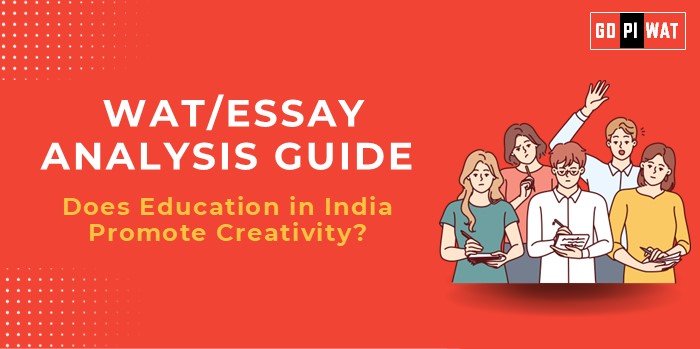📋 Does Education in India Promote Creativity? – WAT/Essay Analysis Guide
🌐 Understanding the Importance of Creativity in Indian Education
The ability to think creatively is essential for solving complex problems, driving innovation, and adapting to a fast-paced world.
This essay topic examines whether the Indian education system, characterized by rigorous academics and a focus on test scores, enables students to develop creativity effectively.
📝 Effective Planning and Writing
- ⏳ Time Allocation: Spend 5 minutes planning, 20 minutes writing, and 5 minutes reviewing.
- 🔍 Preparation Tips: Familiarize yourself with recent data on the NEP 2020, explore examples from other educational systems, and note major challenges such as rote learning.
💡 Introduction Techniques for Essays
- 🔄 Contrast Approach: “While India produces some of the world’s top engineers and doctors, it struggles to cultivate creativity, as the education system remains focused on academic scores rather than fostering innovation.”
- 🤝 Solution-Based Approach: “To truly prepare for a globalized future, India’s education must evolve from rote learning towards fostering creativity—a path that requires systemic reforms and a shift in societal attitudes.”
- 📜 Historical Perspective: “Rooted in centuries of traditional practices, India’s education system has historically valued discipline over creativity, a trend that recent policies like the NEP 2020 are striving to change.”
🏗️ Structuring the Essay Body
- 🏆 Achievements:
- ✨ Experiential Learning Focus: NEP 2020 promotes hands-on, experiential learning, including arts and sports to cultivate creativity among students from early education levels.
- 💡 Institutional Innovation Councils (IICs): With over 7,265 IICs and 106 IDEA Labs nationwide, NEP 2020 fosters innovation-driven culture in higher education, supporting project-based learning and creative pursuits.
- 📱 Ed-Tech Integration: Encourages digital programs like coding and digital arts from early schooling stages, fostering creativity in thousands of Indian schools.
- 🌍 Global Innovation Index: India’s rank improved to 40th by 2022, reflecting educational reforms that prioritize creativity and entrepreneurial learning.
- 🔍 Challenges with Comparative Analysis:
- 📖 Persistent emphasis on rote memorization and test-based assessments.
- ⚠️ Over 50% of educators lack resources for creativity-focused teaching, and only 10% of students feel they reach their creative potential in classrooms.
- 🌏 Countries like Finland and Singapore emphasize balanced academic and creative learning, offering models for Indian reforms.
- 🌟 Future Outlook: NEP 2020 lays the groundwork for instilling creative skills, aiming to meet the demands of a globalized job market. Continued efforts in teacher training, resource allocation, and societal attitude shifts are key to success.
📈 Concluding Effectively
- ⚖️ Balanced Conclusion: “While steps have been taken to promote creativity in India’s education system, a broader cultural and institutional shift is required to balance traditional academics with innovation.”
- 🌏 Global Comparison Conclusion: “India’s education system can learn from creative-focused approaches in countries like Finland, where students excel not only academically but also in problem-solving and innovation.”
🔍 Analyzing Successes and Shortcomings
- 🏆 Key Achievements:
- 🎓 NEP 2020 reforms supporting experiential learning.
- 🚀 IICs and IDEA Labs promoting innovation.
- 📱 Technological integration in classrooms.
- ⚠️ Ongoing Challenges:
- Societal pressures favoring academic success.
- Infrastructure limitations for creativity-focused programs.
- Curriculum that favors memorization over inquiry.
- 🌎 Global Context: Countries like Singapore and Finland provide models for integrating creativity within academic frameworks.
🌟 Recommendations for Sustainable Progress
- 📜 Policy Support: Encourage continuous teacher training in creative pedagogy.
- 💸 Increased Funding: Allocate funds for arts, coding, and design programs in schools.
- 🤝 Parental Engagement: Educate parents on the benefits of creativity to balance societal pressures toward conventional career paths.
📄 Sample Short Essays on Creativity in Indian Education
- ⚖️ Balanced Perspective: “India’s education system, while achieving high academic standards, faces challenges in fostering creativity. Moving from rote learning to experiential and inquiry-based education could provide students with the skills needed for a dynamic global job market.”
- 🤝 Solution-Oriented: “Implementing more hands-on learning and creative projects, as encouraged by the NEP 2020, could transform India’s education landscape, preparing students not only to excel academically but to innovate and lead.”
- 🌍 Global Comparison: “Countries like Finland, with their focus on balanced, creativity-driven education, provide valuable insights for India as it seeks to build a more innovative and adaptive workforce.”


